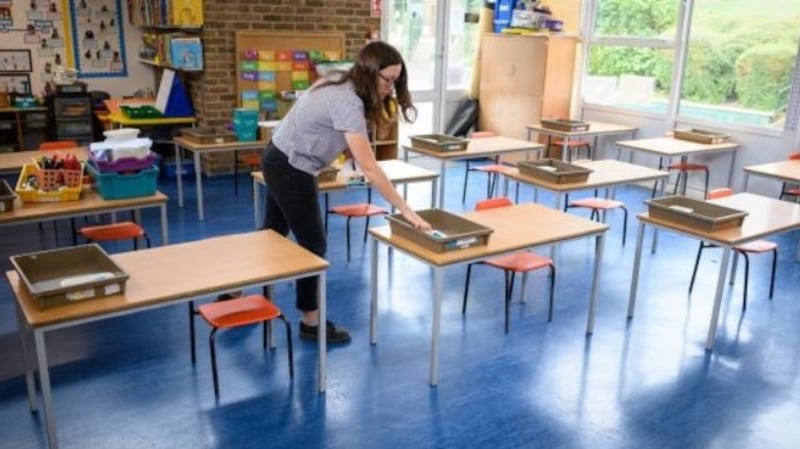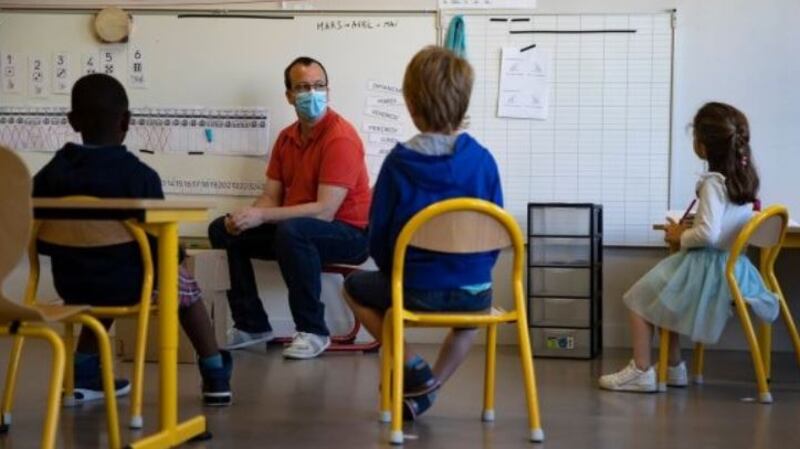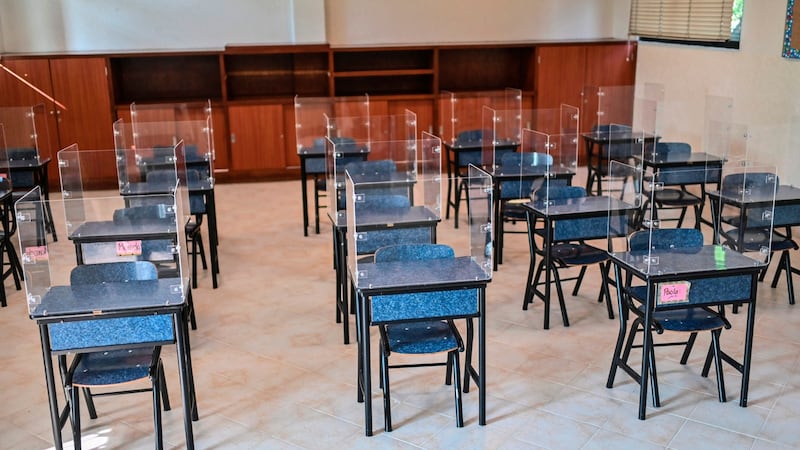Schools all over the world closed their classrooms and sent children home in the early days of the pandemic. Many have returned, many are preparing to. Here is what we know about some of those schools that have already tried reopening, and others like Ireland who are preparing to.
UK
Pupils in the United Kingdom are preparing to return to some kind of classroom normality in September.
Under the terms of a government strategy, if there is a suspected outbreak in a school (defined by two or more confirmed cases within 14 days) or even an overall rise in suspected coronavirus sickness absence, teachers will liaise with local health teams.
Response planning, as reported by the BBC, includes the potential for mobile testing units that would focus on the specific class, and then possibly on the year or even the whole school if necessary.
However, although a large number of pupils may be asked to self-isolate at home, the closure of an entire school, according to the government, “will not generally be necessary”.
Classes will operate in separate “protective bubbles” of class or year groups rather than practising social distancing. Other measures include strict hand-washing, cleaning and testing policies. Unnecessary sharing of school resources such as books is to be avoided.
But authorities are determined to get back to normal. According to the Financial Times, education secretary Gavin Williamson said children would not face a "watered-down curriculum".
“It is going to be a full and total curriculum that is going to be delivered for our children across all subjects,” he said. “We are not going to be in a situation where we see vital subjects cut out of children’s education.”
Previously, schools in the United Kingdom were closed to anyone but children of essential workers.

Denmark
Denmark has been held as an exemplar of reopening since it gradually allowed children to return in April.
At first this was on a staggered basis: initially early childhood and primary schools opened, followed in May by secondary schools. Classes, averaging about 20 pupils, were cut in half and often held outside.
"You cannot see any negative effects from the reopening of schools," Peter Andersen, doctor of infectious disease epidemiology and prevention at the Danish Serum Institute, told Reuters shortly afterwards.
As outlined by the Brookings Institution, a detailed approach was mapped out. This included stipulations that students must be seated at tables at least two metres apart; students must wash their hands every two hours; and materials had to be cleaned twice a day.
In some cases, it said, hours were reduced; parents were not allowed inside and had to drop off students on staggered times; and additional toilet facilities were fitted. Face masks were not mandatory.
The approach was successful – at least so far. The Guardian reported the Danish R number - which measures the rate of infection - rose briefly in the two weeks after pupils up to the age of 11 returned, creeping up from 0.7 to 0.9, but later fell back again.
While teachers expressed some concern about an increase in work hours as a result of the measures, ongoing consultation with unions was flagged as a part of the success.
"As unions, we were taken so much into account, and we were consulted so much that we felt quite safe about this," Dorte Lange, vice-president of the Danish Union of Teachers, told the Guardian.
“We said to our members that we think that we can actually trust the authorities and that it will be ok to go back.”

Israel
Israel may have jumped too quickly. Originally praised for its early crack down on infection spread, the reopening of its schools in May did not go well.
After two months of closure, the government brought in a staggered approach, operated differently in different areas and with the use of “capsules”.
According to the Times of Israel, hygiene rules such as washing hands were enforced, and every pupil had to be certified healthy on return.
Children were all required to wear face coverings during recess in open areas. Older children had to wear them in class, and windows remained open.
However, a heat wave led to difficulties in maintaining the blanket imposition of masks.
"Contrary to our advice, the government decided to open the entire system all at once on May 17th. What happened next was entirely predictable," Hagai Levine, an epidemiologist and chairman of the Israeli Association of Public Health Physicians, told the Daily Beast.
It reported that, two weeks after schools opened, more than 244 students and staff tested positive for Covid-19. In the first two weeks of July, 393 kindergartens and schools closed due to cases.
In early July, Israel’s top public health official, Siegal Sadetzki, resigned over her frustration at how the government was handling the pandemic, noting reopening of schools among her concerns.
Spain
Among the worst-hit countries, Spain’s experience with the virus was keenly watched by its European neighbours. Its efforts to get school children fully back to learning in September will also be closely monitored.
Schools in the country were partially reopened from May 26th, but this was specifically to allow for revision classes and state exams.
According to the El País newspaper, about 8.2 million schoolchildren were doing their lessons from home since classrooms were shut down in March.
By the beginning of June, a gradual return to schools began to creep in. Reuters reported some schools in Madrid reopened for primary pupils, as did others for senior students preparing for university-entrance exams. Other regions were allowing different age groups to return, it said.
Guidelines issued by the Spanish government will mean smaller class sizes, more hygiene measures, and face masks in situations where safety distances cannot be observed.
Crucially, given the challenge of reorganising classrooms and other space, the Spanish authorities decided to reduce the required distance between students from two metres to 1.5 metres.
Groups of up to 20 children (with 15 declared the “ideal” number) will be allowed in early education settings and for students in the first four years of primary school.
Children up to 10 years may “socialise without maintaining a strict personal distance” but will mix as little as possible with other students. Face masks are not compulsory for that younger age cohort.
Older children will be asked to wear masks when it is not possible to keep a distance of 1.5 metres, but not when at their desks. Classroom windows must remain open for as long as possible.
The focus on returning to school is underscored, as in other countries, by the belief remote working is not suitable for many students, particularly those in low-income families.
France
France’s education minister, Jean-Michel Blanquer, called the effects of Covid-19 on schools “a worldwide educational catastrophe”, a view that encapsulated the determination of authorities to get children back into classrooms.
That process began in mid-May, accompanied by the expected health guidelines on hygiene and social distancing. In some cases attendance in schools was reduced to as little as a day and a half per week.
According to the BBC, by May 24th, one in five primary school pupils had returned to class, mainly those from wealthier families.
The education ministry issued 56 pages of detailed instructions on how to keep schools clean and pupils safe. Rules stipulated there be no more than 15 children per class, no shared toys, and timed arrivals at school. Children over the age of 11 were told to wear masks.
For the last two weeks of June the French government required 100 per cent attendance while at the same time a poll in Le Figaro showed 55 per cent of parents were reluctant to send children back. The education ministry estimated about 80 per cent returned.
EuroNews reported that toward the end of June physical distancing measures had been relaxed and the rules around the maximum number of students in a class were scrapped. A one-metre social distancing requirement was recommended in primary schools.

Japan
By comparison to other countries, Japan took a very cautious approach to restarting its education system.
After the lifting of a state of emergency in most of the country last May, the Japan Times reported on pupils trickling back to classrooms amid a variety of safety measures including the avoidance of overcrowding, shortened school hours, and the widespread use of face masks. Photographs emerged of young children behind plastic faceguards.
Despite a determination to avoid outbreaks, the measures were not always popular. The newspaper reported concern among experts that students may begin to dislike the experience of attending school, while online commentary included claims from pupils that “lunch is not fun because conversations are banned”, as was “play during recess”.
According to the Asahi Shimbun daily, teachers were taking "exhaustive measures to protect the children from the virus while helping them catch up on their studies and caring for their emotional needs".
It reported that just half of first-graders, third-graders and fifth-graders attended school on June 1st as part of a staggered system designed to avoid packed classrooms.
Uruguay
Uruguay was the first country in Latin America to fully reopen its school system, opting for a slow, phased approach spreading through various parts of the country.
In April, according to the Inter-American Development Bank, rural educational centres opened first, a move that would gradually spread to urban areas.
Of the first schools to return, El Observador reported that 973 in the interior of the country, less affected by Covid-19, began to welcome back pupils from April 22nd. Attendance was voluntary.
Later, on June 1st, face-to-face classes in schools and high schools began in almost the entire country.
According to the Infobae service, students from public and private schools in the capital Montevideo and its metropolitan area began to return from the end of June.
At that final stage, and although the return to classes was voluntary, authorities expected more than a quarter of a million students across all levels of education to return to school settings.
Among the measures put in place were guidelines for social distancing, a questionnaire about possible symptoms distributed to children and adolescents, the use of face masks, and preparation on what to do if a case of Covid-19 appeared in a school.

Canada
Canadian officials have been examining a dual return to education approach – part classroom, part remote.
In Ontario, the country’s most populous province, Reuters reported the provincial government has also asked schools to prepare an online-only approach with a final decision only expected in August.
Some Quebec elementary schools reopened in May, while British Columbia reopened some schools in late March for the children of essential workers. At the beginning of March it reopened schools to all students on a reduced basis.
Most of the country’s provinces are working on screening and social distancing guidelines for next term.
For many teachers, however, a lack of planning continues to cause anxiety.
"The fear is me going back into the schools surrounded by kids without a solid plan and then coming home . . . it's scary. It's nerve racking," art teacher Kirsten Diachidos told Canadian TV in July.
With September fast approaching, many teachers say they still do not know what the structure of their classes will be.
Provincial governments and school boards across the country are still developing guidelines on how best to reopen, CTV has reported.
Some are considering the hybrid system where half of students attend for part of the week and the other half for the other – a one-week-on, one-week-off approach.













